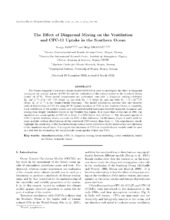The Effect of Diapycnal Mixing on the Ventilation and CFC-11 Uptake in the Southern Ocean
Journal article
Permanent lenke
https://hdl.handle.net/1956/627Utgivelsesdato
2004-03-04Metadata
Vis full innførselSamlinger
- Geophysical Institute [1198]
Sammendrag
The Miami Isopycnic Coordinate Ocean Model (MICOM) is used to investigate the effect of diapycnal mixing on the oceanic uptake of CFC-11 and the ventilation of the surface waters in the Southern Ocean (south of 45°S). Three model experiments are performed: one with a diapycnal mixing coefficient Kd (m2 s-1) of 2 • 10-7/N (Expt. 1), one with Kd = 0 (Expt. 2), and one with Kd = 5 • 10-8/N (Expt. 3), N (s-1) is the Brunt-V¨ais¨al¨a frequency. The model simulations indicate that the observed vertical distribution of CFC-11 along 88°W (prime meridian at 0°E) in the Southern Ocean is caused by local ventilation of the surface waters and westward-directed (eastward-directed) isopycnic transport and mixing from deeply ventilated waters in the Weddell Sea region. It is found that at the end of 1997, the simulated net ocean uptake of CFC-11 in Expt. 2 is 25% below that of Expt. 1. The decreased uptake of CFC-11 in the Southern Ocean accounts for 80% of this difference. Furthermore, Expts. 2 and 3 yield far more realistic vertical distributions of the ventilated CFC-waters than Expt. 1. The experiments clearly highlight the sensitivity of the Southern Ocean surface water ventilation to the distribution and thickness of the simulated mixed layer. It is argued that inclusion of CFCs in coupled climate models could be used as a test-bed for evaluating the decadal-scale ocean uptake of heat and CO2.
